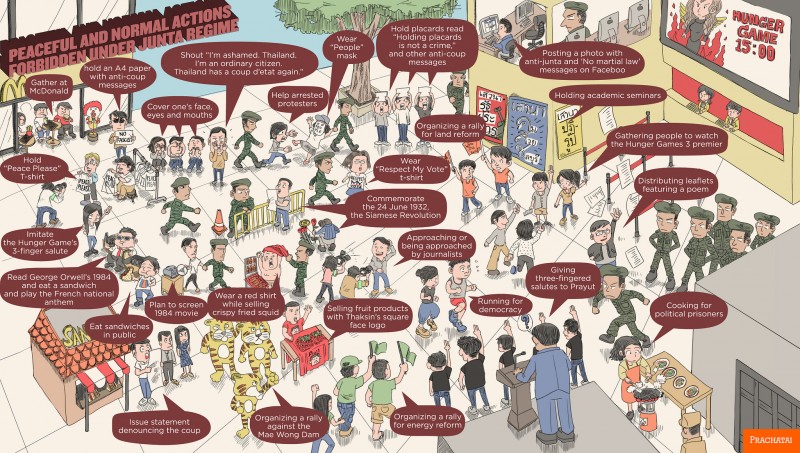The infographic above, created by the independent news portal Prachatai, offers a snapshot of the current situation in Thailand, where the army has been in power for the last year, after staging a coup.
Thailand’s army, led by General Prayut Chan-o-cha, grabbed power in a coup last May, later imposing martial law nationwide. The army also suspended the constitution, detained political leaders, placed strict controls on the media, and banned public protests.
The army claimed the coup was necessary to restore stability and end the intense street clashes between various political forces. It vowed to restore civilian rule, but only after implementing certain political and electoral reforms.
An interim constitution was approved last August, followed by the appointment of military-backed civilian authorities led by General Prayut, who is now the country’s prime minister. A legislative body was also established, though all its members are all appointed by the military.
Since day one of the coup, Thai activists have resisted the military dictatorship. Ordinary citizens have since joined the country's devoted activists in demanding the restoration of elections and other democratic rights. The junta's response has been to detain protesters and subject supposed critics to “attitude-adjustment” treatment.
But Thais have resorted to creative means of expressing dissent. Because public gatherings of five or more people are banned, individual protesters have delivered their messages in subtle ways, such as reading George Orwell’s novel 1984 aboard trains, imitating the Hunger Games‘ three-fingered salute, and playing the French national anthem.
Prachatai‘s infographic lists some of the ordinary activities the authorities have suppressed over the past nine months. People who've “committed” these acts have been arrested for “undermining Thailand's national security.” The junta's paranoia runs deep.
- Holding a blank A4 paper or A4 paper with anti-coup messages
- Covering one’s face, eyes, and mouth
- Helping arrested protesters
- Holding “Peace Please” T-shirt
- Imitating the Hunger Games three-fingered salute
- Gathering at McDonald’s
- Reading George Orwell’s 1984 novel
- Eating sandwiches in public
- Playing the French national anthem
- Wearing a Red Shirt while selling crispy fried squid
- Issuing a statement denouncing the coup
- Wearing “people” mask
- Wearing “respect my vote” t-shirt
- Approaching or being approached by journalists
- Running for democracy
- Holding placards that read “holding placards is not a crime”
- Posting a photo with anti-junta and “No Martial Law” messages on Facebook
- Holding academic seminars on the political situation
- Gathering people to watch the premiere of Hunger Games 3
- Distributing leaflets featuring a poem about democracy
- Giving three-fingered salutes to Prayuth, the leader of the junta
- Selling fruit products with (former Prime Minister) Thaksin Shinawatra’s square face logo
According to Prachatai, the junta’s suppression of the right to free speech has further alienated the public from the regime:
Although these anti-junta actions have resulted in intimidation, arrest, detention, and lawsuits from the military, the junta’s draconian measures to suppress people who simply want to exercise their basic rights only drive more people against the regime.








18 comments
half of them associated with red shirt or former government politician.
the other half is normal people that protest about national interest and etc.